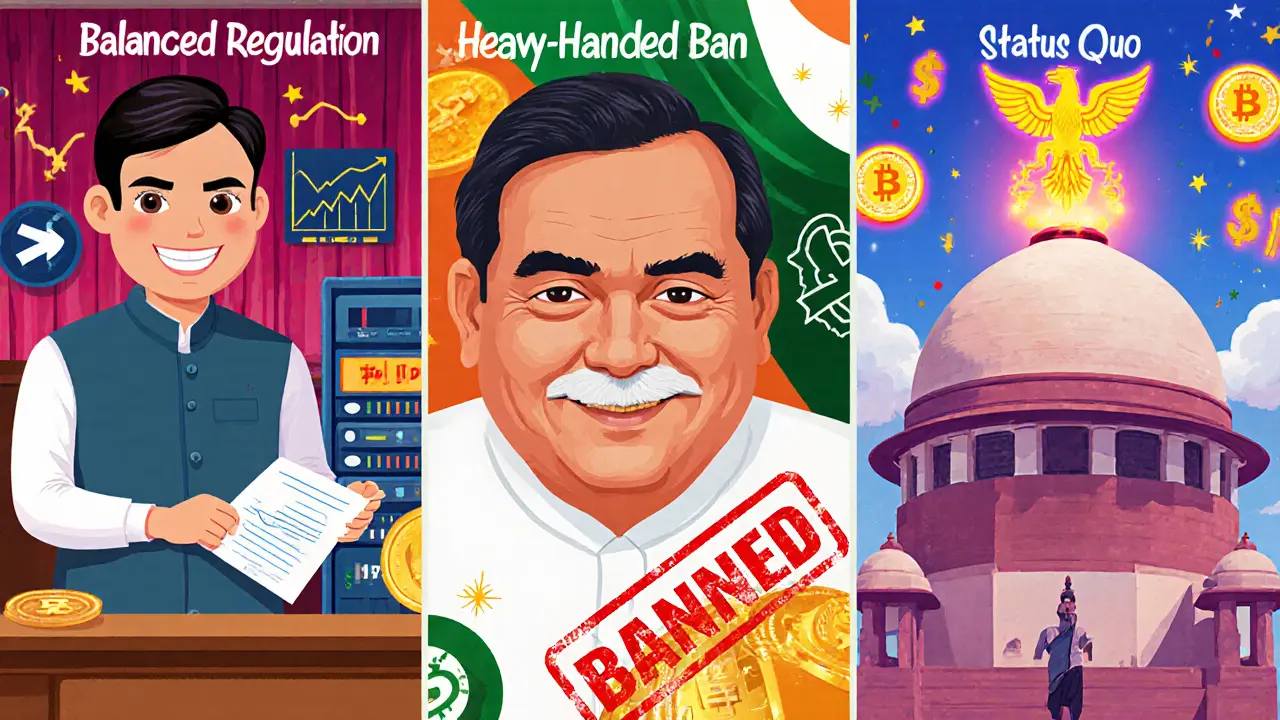India Crypto Tax Calculator
Crypto Tax Calculator for Indian Traders
Calculate your tax liability based on India's 30% flat tax on gains plus 1% TDS on transactions above INR 50,000
When the Supreme Court of India issued its 2020 decision striking down the Reserve Bank’s blanket ban on virtual currencies, the country’s crypto scene went from murky to suddenly legal‑friendly. That ruling still shapes how traders, exchanges, and lawmakers behave today, and the court keeps nudging the government toward a full‑blown framework. If you’ve been wondering what the judgment really means for your crypto wallet, taxes, or a startup, this guide breaks it down step by step.
Why the 2020 Decision Was a Game‑Changer
The case Internet and Mobile Association of India v Reserve Bank of India (AIR 2021 SUPREME COURT 2720) targeted an April 2018 circular that told every bank, payment gateway, and NBFC: “Don’t deal in virtual currencies (VCs).” The court found that blanket prohibition disproportionate and unconstitutional because there was no specific law banning crypto. It applied the principle of proportionality, basically saying the RBI’s ban was a hammer for a nail that didn’t even exist.
- All Indian crypto exchanges could reopen overnight.
- Users could once again move money between fiat accounts and crypto wallets.
- Businesses gained the legal foothold to offer KYC‑compliant services.
In short, the judgment turned a total shutdown into a green light for basic trading, even though the government still hadn’t drafted a detailed rulebook.
The Core Legal Reasoning
The judges, including Justice B.R. Gavai and Justice N. Kotiswar Singh, emphasized two constitutional pillars:
- Freedom of trade - the RBI’s ban curbed a legitimate economic activity without a supporting statute.
- Proportionality - a total ban was excessive given that crypto posed no proven systemic risk at the time.
The court ordered the RBI to stop enforcing the circular, effectively legalising crypto trading while leaving the door open for future regulation.
How India’s Approach Differs From the US and EU
| Jurisdiction | Legal Basis | Key Tax Rate | Regulatory Body |
|---|---|---|---|
| India | Supreme Court judgment (2020) + pending legislation | 30% flat tax on gains + 1% TDS per trade | Reserve Bank of India (RBI) & Income Tax Dept. |
| United States | SEC & CFTC guidance; IRS treats as property | Capital‑gains rates (0‑37%) + 30% for short‑term | SEC, CFTC, IRS |
| European Union | MiCA (Markets in Crypto‑Assets) framework | Variable - typically 20‑26% corporate tax + 0‑30% capital gains | European Securities & Markets Authority (ESMA) |
India’s court‑driven model is unique: instead of a legislative or agency‑driven roadmap, the judiciary stepped in to prevent overreach. The result is a market that can trade but faces one of the world’s highest crypto tax regimes.

Tax Realities for Indian Traders
Even though the Supreme Court opened the doors, the government slapped on a 30% flat tax on any crypto profit, regardless of holding period, plus a 1% Tax‑Deducted‑At‑Source (TDS) on each transaction above the prescribed threshold. That means every time you sell Bitcoin, you owe 1% of the gross amount right away, and you’ll later calculate the 30% on the net gain.
- Maintain a detailed ledger for every buy, sell, and transfer.
- Use accounting software that can handle crypto‑specific fields (cost basis, fair market value, etc.).
- File Form 26 AS for TDS and disclose crypto gains in your income‑tax return.
Because the tax applies uniformly, short‑term traders often feel the rates are prohibitive, whereas long‑term holders argue the flat rate is simpler than the US’s complex capital‑gains tiering.
Impact on Exchanges and the Wider Ecosystem
After the judgment, home‑grown platforms such as WazirX, CoinDCX, and ZebPay reported registration spikes of 300‑400% within months. Their user bases now sit around 15‑20 million nationwide. However, the lack of clear rules on DeFi, NFTs, and cross‑border transfers still creates gray zones.
Exchanges have responded by tightening KYC, integrating blockchain analytics tools, and hiring tax‑advisory teams to help users navigate the 30% tax and 1% TDS.

Judicial Outlook: Recent 2025 Developments
In October 2025 the Supreme Court held a bail hearing for a Gujarat resident accused of crypto‑related fraud. Justices Justice Surya Kant and Justice N. Kotiswar Singh used the platform to criticize the government’s “blind eye” on comprehensive regulation. They reiterated that a total ban would be “unwise” given global financial trends, but some form of oversight is essential to curb money‑laundering and protect consumers.
The Court’s repeated pressure has kept the Cryptocurrency and Regulation of Official Digital Currency Bill, 2021 in the spotlight. The bill proposes banning private tokens while promoting a Central Bank Digital Currency (CBDC). It has yet to become law, leaving investors in limbo.
Practical Steps for Investors and Startups
Whether you’re a retail trader or a fintech founder, here’s a quick checklist to stay compliant:
- Set up a robust KYC workflow - use Aadhaar‑linked verification and facial‑recognition checks.
- Record every transaction with timestamps, amount in INR, and market value at the moment of trade.
- Calculate 30% tax on net gains for the fiscal year and file it before July 31.
- Include crypto gains under “Income from Other Sources” in ITR‑2.
- Deduct 1% TDS from each sale and ensure the exchange issues Form 16A for your records.
- Consult a chartered accountant familiar with crypto‑tax law for quarterly reviews.
- If you’re building a DeFi or NFT platform, wait for official guidance - currently the RBI treats them as “unregulated financial services”.
Following this roadmap can shield you from surprise penalties and keep your operations running smoothly while the legislature catches up.
Future Scenarios: What Could Happen Next?
Analysts see three plausible paths:
- Balanced Regulation: Parliament passes a nuanced law that retains the Supreme Court’s freedom‑to‑trade stance, lowers the tax to a tiered system, and defines clear rules for DeFi and NFTs.
- Heavy‑Handed Ban: The government finally enacts the 2021 Bill, banning private crypto and pushing a state‑run CBDC. Existing exchanges would have to shut down or pivot to fiat services.
- Status Quo with Incremental Guidance: The Supreme Court continues to press, the RBI issues advisory circulars, and tax rates stay the same, leaving the market to self‑regulate.
Given the Court’s latest remarks, the first scenario feels most likely, but investors should hedge against the other two by diversifying holdings and staying legally vigilant.
Is cryptocurrency legal in India after the Supreme Court ruling?
Yes. The 2020 Supreme Court judgment removed the Reserve Bank’s blanket ban, allowing individuals and businesses to trade crypto, but the activity remains subject to tax and future regulation.
What taxes do I need to pay on crypto profits in India?
A flat 30% tax on any profit, plus a 1% Tax‑Deducted‑At‑Source (TDS) on each transaction above the prescribed threshold. Both must be reported in the annual income‑tax return.
Do Indian exchanges need a special licence to operate?
Exchanges must register as Money‑Service‑Business Providers (MSBs) with the RBI, comply with KYC/AML norms, and maintain detailed transaction logs for tax authorities.
How does India’s crypto tax compare globally?
India’s 30% flat rate + 1% TDS ranks among the highest worldwide. The US taxes at progressive capital‑gains rates, while the EU varies by member state under the MiCA framework.
What is the status of the Central Bank Digital Currency (CBDC) in India?
The RBI is piloting a wholesale CBDC called “Digital Rupee” for inter‑bank settlement, but a retail CBDC for the public is still under study and not yet launched.

19 Comments
Derajanique Mckinney
lol crypto tax in india is wild 😂 30%?! i just buy and hold and pretend it’s not happening
Sheetal Tolambe
Honestly, I’m just glad we can trade at all. The tax is rough, but at least we’re not banned like in China. Keep going, India!
Saurav Deshpande
Supreme Court didn’t legalize crypto. They just stopped the RBI from being lazy. The real power still sits with the government waiting to crush us. Trust no one.
Will Barnwell
30% flat tax? Bro, that’s worse than the US. You’re taxed on gross gains, not net. And 1% TDS on every trade? That’s a liquidity killer. This isn’t regulation, it’s extortion.
Henry Gómez Lascarro
Let’s be real - this whole thing is a joke. The Supreme Court stepped in because the RBI is incompetent, not because crypto has merit. And now we have this half-baked tax regime that punishes small traders while letting whales slip through. The government doesn’t want to regulate - they want to control. And the 1% TDS? That’s surveillance disguised as taxation. Every transaction tracked. Welcome to the digital panopticon.
Kirsten McCallum
You people act like this is progress. It’s not. It’s a tax trap with a side of false freedom.
Matt Zara
I get why the tax is high - they’re trying to catch people who think crypto is a tax loophole. But honestly? Most of us just want to hold Bitcoin and not get audited. Maybe a tiered system would’ve worked better. Still, better than a ban.
Dr. Monica Ellis-Blied
The Supreme Court’s decision was a constitutional victory - but it’s being undermined by fiscal overreach. A 30% flat tax on capital gains ignores inflation, holding periods, and the very nature of speculative investment. This isn’t taxation; it’s punitive confiscation disguised as policy. And the 1% TDS? It’s a digital chokehold on liquidity. If the government truly wanted to foster innovation, they’d align with global standards - not punish retail investors with Byzantine rules.
Frech Patz
I’m curious - how many people actually file their crypto taxes correctly? I’ve met so many who just ignore it, assuming the government won’t catch them.
Anna Mitchell
I’m so proud of India’s judiciary for stepping in. It’s rare to see courts protect economic freedom like this. The tax is annoying, but at least we have a chance.
jummy santh
As a Nigerian, I’m watching this with interest. India’s approach is unique - judicial intervention before legislation. In Africa, we’re still struggling with outright bans. Maybe this can be a model? The tax is steep, but transparency > prohibition any day.
james mason
You know what’s funny? The same people who scream about financial freedom are now begging for government oversight. Classic. The 30% tax? That’s not regulation - that’s the state saying, ‘We let you play, but we’re taking the pot.’
Lawrence rajini
I’ve been trading since 2020 and honestly? The 30% tax is brutal, but I’d rather pay it than have my account frozen. Also, 1% TDS is annoying but it’s automated - no paperwork. Big win. 🙌
Herbert Ruiz
The ruling was meaningless. No law = no legal standing. The government can ban it tomorrow. This is theater.
William P. Barrett
The court didn’t legalize crypto - it just said the RBI couldn’t ban it without parliamentary backing. That’s a procedural win, not a philosophical one. Crypto still exists in a legal gray zone, sustained by judicial restraint, not legislative clarity. The real question isn’t whether it’s legal - it’s whether the state will ever allow it to be free.
Sunny Kashyap
India doesn’t need crypto. We need jobs. This is just rich people gambling with digital ghosts. Tax them hard and move on.
gurmukh bhambra
You think the government doesn’t have a backdoor? Every exchange is feeding data to the NIA. The 1% TDS? That’s not tax - that’s a spy tool. They’re building a digital fingerprint of every Indian with crypto. One day, you’ll wake up and your wallet will be frozen for ‘suspicious activity’. I told you so.
Jean Manel
The 30% tax is a disaster. It makes trading unviable. Only the ultra-rich can afford to play. Everyone else gets crushed. This isn’t regulation - it’s a wealth transfer scheme disguised as fiscal policy. The RBI and IT dept are just looting retail investors under the guise of ‘compliance’.
Rosanna Gulisano
If you’re paying 30% tax on crypto you’re doing it wrong